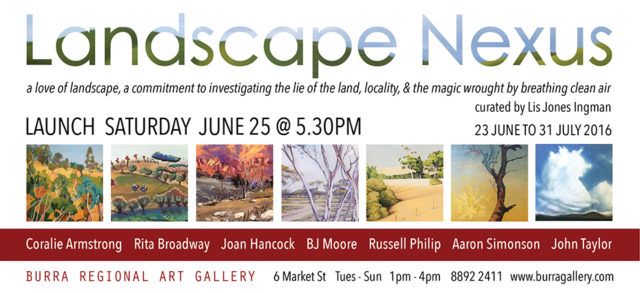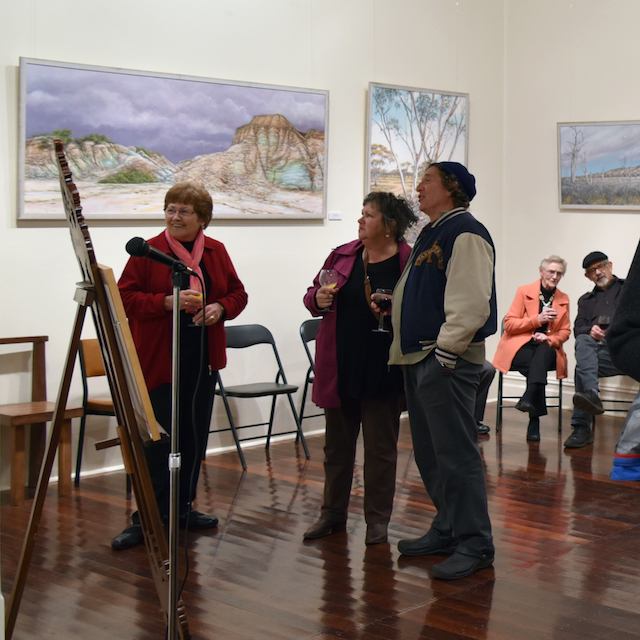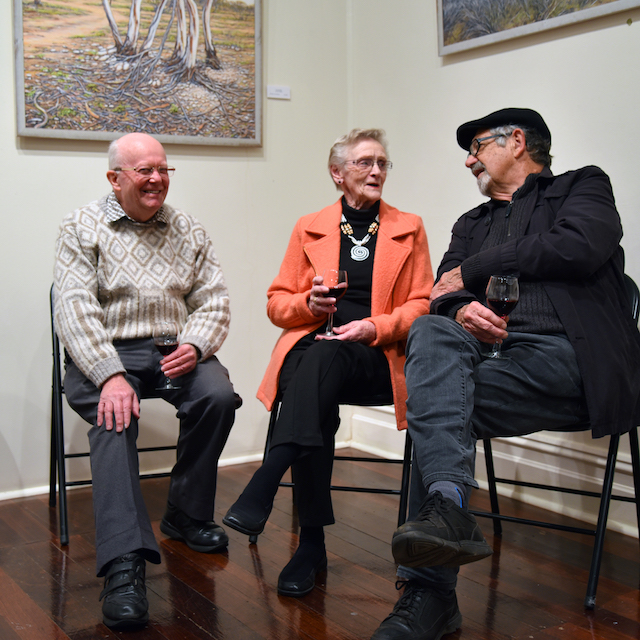Landscape Nexus

Dieter Engler as our opening speaker engaged in conversation with curator Lis Jones Ingman re each artists approach. He has kindly provided notes he made for the evening…

Joan Hancock
Joan’s love of the Flinders Ranges shines through in her work. In fact Joan cannot help but let it gush forth in a thick, buttery display of paint full of wonder and riches that she is eager to share with those who take the time to look. While Joan’s technique is exemplary, her real gift to us is the narrative quality to the work. She seems keen to tell us the story of each place and the details that are important to her. They are in some respect a western dreaming of country.
Rita Broadway
For Rita painting was about life and living. Her joyous works of pattern and colour are a communion with nature and its deeply life-giving forces. For Rita, to paint the landscape was to forget the troubles of life and to let herself be immersed in nature’s endless variety and gifts. Her brushwork in these works is deft and imaginative, fuelled by the light of the sun and the multiplicity of the natural world that her keen eye and spirit witness to. Painting for Rita was a form of salvation that freed her from the boundaries and troubles of life with these works a record of that joyful worship.
John Taylor
These very personal works by John Taylor are like visions. They are not so much records of the world but imprints of his mind. They seem to have come to him in a moment, a flash or glimpse into some other reality. The surface of the work reveals no great labour as if the images appeared by themselves via some mysterious process we can only guess at. In many ways they are simply the images of what we have seen too, but John manages to make them stranger, stronger and more real than reality itself.
B.J. Moore
B.J is a draughtsman. These are not so much paintings as drawings made of paint. The drawing process for him is one of making the world clear and precise, placing it onto a surface that now becomes a record that can no longer be argued with. These works are strong in scale and composition with a cool sense of colour, as if B.J. is reticent to give us all of his emotions in case they interfere with our own encounter with his chosen subjects. In the end his works are powerfully expressed sites of reflection on the landscape.
Aaron Simonson
Aaron’s work in this exhibition is an exploration of Lake Bonney, but even more so, it is an encounter with light, water and air. In that sense they are material counterparts of what is most elusive in the landscape. These works are full of surprising moments as Aaron tries to find physical and stable visual equivalents of what is otherwise vaporous and momentary. That he combines this interest in these eternal like elements of the landscape with dead trees is of interest and brings us abruptly back to our more finite senses in case we should get lost in the ethereal.
Russell Philip
Russell Philip’s art explores the subtlety of emptiness in his beautifully rendered and classically composed landscapes. The large areas reserved for sky reflect an interest in the transcendent that oversees and gives mood to the earth and its human landmarks. These landscapes seem full of an unspoken history, exploring our relationship with some unknown but overarching plan. Crucial to all of Russell’s work is the presence of light as a deeply mystical, timeless illumination that fills, shapes and surrounds the land (and our small presence in it) to give it (and us) meaning and permanence.
Coralie Armstrong
Coralie’s appealing work relies in good part on her ability to combine science and aesthetics. Science in her analysis of the structures and design inherent in the natural world and aesthetics in the ability to record her discoveries in terms of colour, light and poetry. Thus they appeal to both our rational and romantic selves, creating for us images that are clearly defined and yet poetically warming. This is particularly true of her oils in this exhibition while her two watercolours reveal a more spontaneous and immediate response, allowing her lyrical inclination to come more to the fore.
Dieter Engler











